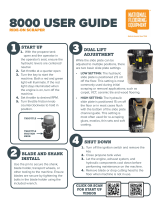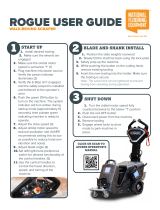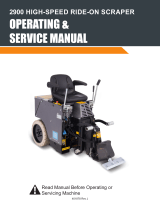Page is loading ...

OPERATING MANUAL BMS-220LP-V2
VERSION 1.1
www.blastrac.com 1-800-256-3440

2
Table of Contents
1. Introduction .......................................................................................................................................... 3
2. Machine Description ............................................................................................................................... 3
3. Safety .................................................................................................................................................. 4
Safety Precautions ............................................................................................................................... 4
Safety Regulations ............................................................................................................................... 4
Safety Instructions ............................................................................................................................ 5-7
4. Initial Operation..................................................................................................................................... 8
Checkpoints of Gas Cylinder Safety: ....................................................................................................... 8
Checkpoints of Machine Safety: ............................................................................................................. 8
5. Operation ............................................................................................................................................. 9
Driving the Machine ............................................................................................................................ 10
Controlling Tool Position Cylinder ......................................................................................................... 11
6. Maintenance ................................................................................................................................... 12-13
Hydraulic System Instruction .......................................................................................................... 14-15
7. Cutting Head & Blades ..................................................................................................................... 16-18
8. Blade Application ............................................................................................................................ 19-23
9. Ditching ......................................................................................................................................... 24-25
10. Technical Data ................................................................................................................................... 26
11. Contact ............................................................................................................................................. 27

3
1. Introduction
It is important that all persons who are working or maintaining this machine read the manual carefully and
understand it fully. Keep this manual near to the machine, so it can always be consulted.
Only authorized and trained personnel may operate this machine.
2. Machine Description
The Blastrac BMS-220LP ride-on scraper is ideally suited for medium and large sized applications with the added
benefit of being gas operated for increased versatility. It is very maneuverable with zero turn radius, non-mark
tires and complete hydraulic control.
Main advantages of the BMS-220LP:
- Fast and easy removal of all types of flooring material
- Very compact, goes through standard doors & elevators
- Zero turn radius, ergonomic design for safe maneuvering, non–marking tires
- Very versatile, total freedom of movement, no electric cable.
- Complete hydraulic control (drive and tool control)
- Powered by a heavy duty motor delivering strong power with no worries of charging.
- Very high output compared to manual material removal.

4
Update image to new 220LP?
1
Left Wheel Drive Lever
6
Tool Holder
2
Tool Lift/Lower Lever
7
Propane Tank (Liquid Propane Type)
3
Ignition
8
Engine Cover
4
Tachometer/Hour Meter
9
Right Wheel Drive Lever
5
Throttle
3. Safety
It is important that all persons who are working with or maintaining this machine must read the manual carefully
and understand it fully.
Always keep this manual with the machine, so it can be referenced to at any time.
Safety Precautions
Make sure that persons who are not operating the machine are not in the surrounding area of the
machine.
Make sure that there is nothing standing or situated on the surface to be treated
Make sure that there are no cables or hoses in the driving direction of the machine.
Always drive backwards when driving up to a ramp or grade, and forwards when driving down the ramp.
Do not consume drugs or alcohol prior to or during the use of this machine.
Safety Regulations
Never change anything from the safety devices on the machine!
Persons who are not operating the machine must not be permitted to stay within 20 feet of the machine.
Always call a skilled electrician or your distributor when you have questions about the safety of the
electrical components.
Work on electrical equipment or operating materials may only be undertaken by a skilled electrician or by
trained persons under the guidance and supervision of a skilled electrician as well as in accordance with
the electrical engineering regulations.
The following sticker is placed on the machine.
Personnel must tie back long hair and not wear loose clothing or jewellery including rings.
Wear gloves and dust mask during operation of the machine.
Meanings of these symbols are:
Ear protection is required
Safety glasses with lateral
protection are required
CE-mark on this machine
Safety shoes required
Consult the manual before
operating the machine

5
Safety Instructions
Turn key to OFF when machine is parked.
o Park the machine always on a flat horizontal and levelled surface.
o Cover the sharp blade or remove it when the machine is off.
Make sure the machine is clean and that the footrests are dry and free of grease and oil.
NEVER lift the machine with the mounted tool for maintenance! This sharp tool can be very dangerous!
The weight of the BMS-220LP is 2000 pounds. Only use an appropriately sized lift or crane to move/hoist
the BMS-220LP. The lift points are as shown below.
Chock wheels for transport and keep control handles in neutral position.
Don’t leave the machine unsecured on jobsites.
Machine can be lifted by a forklift. For this use prepared bracket (1) on bottom of machine:

6
Be aware of your surroundings and machine operating level. Do not run across hill, do not run on steep
incline, this could cause machine to tip over.
Always drive backwards when driving up to a ramp or grade, and forwards when driving down the ramp.
Do not run the machine in unsafe environments.

7
Engine Safety
DANGER: Engine exhaust gases contain poisonous carbon monoxide. Carbon monoxide
is odorless and colorless and can cause injury or death if inhaled. Do not use equipment
indoors without adequate ventilation. Refer to OSHA guidelines and regulations
concerning maximum levels of exposure to carbon monoxide gases and other hazards
associated with using internal combustion engines. It is highly recommended that a CO
(carbon monoxide) detector be used to warn the user if levels become unsafe.
Warning: Engine, exhaust system and hydraulic component temperatures could be in
excess of 200F causing severe burns if touched.

8
4. Initial Operation
Before using the machine it is essential to inspect the machine every day.
It is not permitted to use the machine if it does not pass all of the checkpoints below.
Checkpoints of Gas Cylinder Safety:
Check the bottle for any damage before use.
Ensure hose to gas cylinder is fully seated and sealed before turning on the bottle.
Always turn the bottle completely on before starting the engine.
Always turn the bottle completely off after using the machine.
Checkpoints of Machine Safety:
Control levers should be in neutral position.
All hydraulic hose connections are tightened and there is no leakage of oil.
The safety functions and operating functions work correct.
There are not any loose nuts or bolts.

9
5. Operation
During the operation of the BMS-220LP, the following additional safety instructions must be followed closely.
Switching on the Machine:
Turn the valve on the propane tank CCW until it stops.
Take place on the seat (2) and put feet on the footrests. Operating the machine without being seated is
not possible because of the safety switch of the seat.
Turn the key contact switch (1) to the right.

10
Driving the Machine
The wheels of the machine are controlled by the two outside handles (1 and 3). Pushing both handles forwards,
the machine drives forwards. Pulling both handles backwards, the machine drives backwards. The driving speed
depends on the position of the handles. Pushing the right handle forwards the machine turns to the left. Pushing
one handle forwards and pulling another handle backwards the machine will turns around its axis. Correcting
direction while moving is accomplished by slightly reducing pressure on one handle or the other while moving.
1) Left wheel control handle.
2) Tool positioning control handle.
3) Right wheel control handle.

11
Controlling Tool Position Cylinder
The tool position cylinder is controlled by the left inner handle. Push the handle to lower the tool and pull the
handle to lift the tool to the proper cutting angle. Continuing to push the handle will lift the front of the machine.
This will need to be done when doing maintenance on the machine. When lifting the machine like this, immediately
place blocks under the machine. Never use the cutting head only.
1) Hydraulic cylinder
2) Debris deflector
3) Cutting head - set

12
6. Maintenance
Warning: Engine, exhaust system and hydraulic component temperatures could
be in excess of 200 F causing severe burns if touched.
Pay attention to Chapter 3 "Safety" during maintenance and repair works.
Failures due to inadequate or incorrect maintenance may generate very high repair costs and long downtimes of
the scraper. Regular maintenance, therefore, is imperative.
Operational safety and service life of the scraper depend, among other things, on proper maintenance.
The following table shows recommendations about time, inspection, and maintenance for the normal use of the
scraper.
Operating hours/
time period
Inspection points, maintenance instructions
12 h after repairing
Check all accessible screw connections for tight seat.
Daily and prior to
starting work
Check all safety devices working adequate.
Check the function of the residual current operated device.
Check the hose connections for tightness and fixed seat.
Check the electric connections for sediments of dirt or foreign bodies.
Check the electric motors for dirt and other contaminants.
Annually
Full overhaul and cleaning of the complete machine.
The time indications are based on uninterrupted operation. When the indicated number of working hours is not
achieved during the corresponding period, the period can be extended. However a full overhaul must be carried out
at least once a year.
Due to different working conditions it can’t be foreseen how frequently inspections for wear checks, inspection,
maintenance, and repair work ought to be carried out. Prepare a suitable inspection schedule considering your own
working conditions and experience.
Our specialists will be happy to assist you with more advice.

13
Follow additional operating and maintenance of OEM if included during
your service and maintenance work.
Store the cleaned and dry machine in a dry and humid free room. Protect the components from moisture, heat,
dust and shocks.
All repair work must to be done by qualified Blastrac personnel, this is to guarantee a safe and reliable machine.
Any guarantee on the machine is expired when:
Non original Blastrac parts have been used
Repair work is not done by qualified Blastrac personnel
Changes or conversions without the express written consent of Blastrac NA

14
Hydraulic System Instruction
To check the oil level on the side of the tank is an installed indicator. The level shouldn’t be lower than half the
range of the indicator. Next to the indicator is a plug which can be removed to fill the reservoir.
1) Oil level indicator
2) Plug to refill oil in tank
At least one time during the year the oil from system and filter should be replaced. For this operation disconnect
the battery as well as remove the LPG tank. The oil drain plug is located on the back of the machine near the rear
axle.

15
3) Drain plug
4) Oil filter
Before doing any maintenance, disconnect the power and block machine in stable position. Because most of
fittings in machine are O-ring style, it is important is to know how to solve O-ring leaks. Fittings should be
tightened with the proper wrench size. Over tightening could damage O-rings. If a leak still persists, remove fitting
and replace O-ring.

16
7. Cutting Head & Blades
Weight vs. Sharpness
The most common way to compensate for a dull blade is to add more weight and raise the blade angle (see re-
scrape setting). Weight allows dull blades to be used to a point. Weight also causes blades to dull and break
easier. Blades of any thickness tend to catch cracks and expansion joints and will bend or break the blade if set at
a high angle. For best results, run a small ditching blade at a low angle to identify as many cracks and joints as
possible. If blades are breaking, you are misunderstanding the conditions.
Cutting Head Angle
Set the cutting head angle to where the material comes up the easiest. The lowest is usually the best.
Steep Cutting Head Angle
A steep angle is only used for re-scraping. The slide plate has to be raised so the bottom of the slide plate is
higher or even with the bottom of the guide channels. Not raising the slide plate when operating the machine at a
steep angle will cause the machine to jump and buck. It does not give the operator a clear vision of the cutting
head and it causes the machine to operate at an unsafe operating height. Failure to raise the slide plate could
cause machine damage and/or bodily injury.
Swivel Head
The swivel head keeps the blade in contact with the floor even when the floor is uneven. When using a flat blade
with no bevel, flipping the blade to the other side after it dulls is one of the fastest methods to keep the machine
running as much as possible.
Saving Time With Extra Cutting Heads
The machine is supplied with one cutting head. Having additional cutting heads will save time on the job. Insert
blades into the extra cutting heads before starting a job. When the blade is dull, instead of taking the time to
replace it or sharpen it on the job, take out the cutting head and replace it with another. When a different type or
size of blade is needed, you can already have them ready in additional cutting heads.

17
1) Tool – depending of the needs
2) Tool holder – lower part
3) Tool holder – upper part
4) Tool holder
5) Debris deflector – new holder shape
6) Universal lower cutting head support
Cutting Head Insertion
With machine off, insert desired cutting head into cutting head holder. Secure with cutting head clip.
Shank Blade Insertion
Shank blades do not require a cutting head. Insert desired shank blade into cutting head holder. Secure with
cutting head clip.

18
Blade Setting
• Dull blades greatly reduce cutting ability. Re-sharpen or replace as needed.
• Proper blade size and placement, depending on material and sub-floor type, affects performance.
• If the material isn’t coming up easily, use a smaller blade for best results.
• Start with a narrow blade, then increase blade size to optimize cutting pass. Narrower blades work
easier than wider blades and usually clean the floor better. Wider is not always better or faster.
• Normally bevel on blade is up for concrete. Bevel down for wood and shoe blades for soft sub-floors.
• KEEP BLADES SHARP.
• Dull blades greatly affect the performance of the machine and reduce cutting ability, re-sharpen or replace as
needed.
• Keep your work area clean and clear of debris.
• After you have removed a portion of material, remove it out of the way. This will give the machine maximum
performance and help to keep the work area safe.
• Always wear gloves when handling blades.
• Everyone in work area should wear eye protection.

19
8. Blade Application
A great deal of work can be accomplished in a short amount of time using the scraper. To do this however, the
operator must use the correct blade type and correct blade angle. Often when the blade begins to dull, it is
tempting to raise the angle of the blade. This method can be used for small amounts of time to ensure the same
quality of cut; however, too high of an angle can result in broken blades. When the angle of the blade to the floor
is too great, the machine can also buck and jump resulting in a tip over, and grave injury to the operator. Never
operate the machine at an angle is that unsafe for the working conditions of the job.
When the blade is dull it is necessary to immediately sharpen or replace. In that operation a second cutting head
can be immediately swapped on to save time. When the machine is running on the second set of tooling the first
set can be serviced to ensure constantly ready tooling.

20
Many different floor conditions exist but the hard and fast rule for scraping is that the tougher the material being
removed, the skinnier the blade. The best course of action is to start small and the move to wider blades as per
the conditions of the job. Generally speaking, wood floors require the bevel to be faced down, as shown below:
On concrete the bevel must be faced upwards:
Concrete Floor
Wood Floor
/





